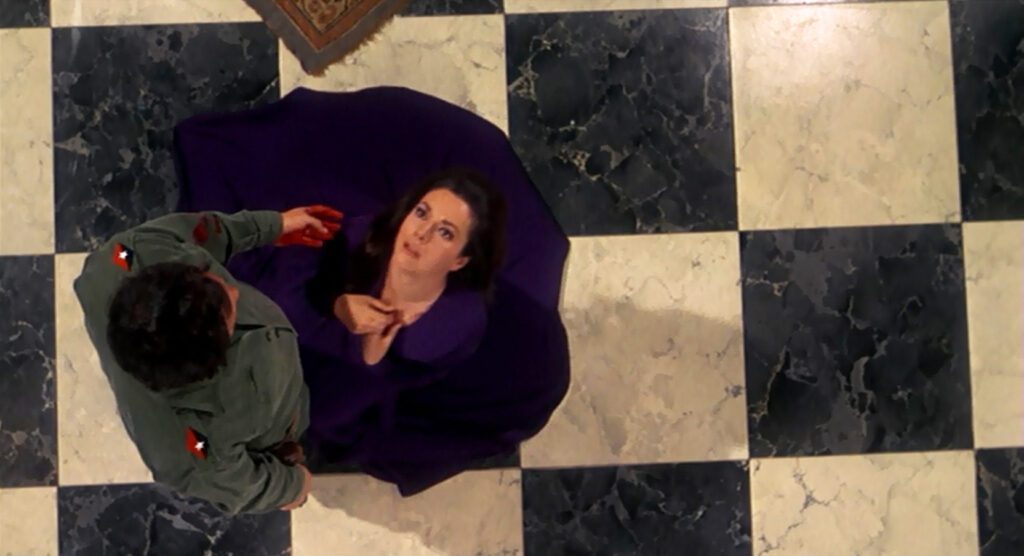
Topaz
1969, directed by Alfred Hitchcock
Near the beginning of Topaz, during a tour of a ceramic factory in Copenhagen, the defector’s daughter deliberately drops and shatters a porcelain figurine in order to escape from the Soviet agent tracking her. The figurine depicts a man and a woman joined in a single piece. Given the importance of marriage in Hitchcock’s films, the destruction of this ornamental couple looks like a sure sign of an actual human couple’s imminent break-up. In fact the leading couple in Topaz, Mr. and Mrs. Devereaux, will be torn in two directions as they end up cheating on each other; but the smashed porcelain couple foreshadows so much more than that.
For starters, the porcelain belongs to a wider pattern like the circles in Shadow of a Doubt or the doors which appear so insistently in Spellbound. Wherever you look in Topaz there are flowers, floral curtains, ornaments, or other forms of decoration, whether in the porcelain factory or department store in Copenhagen, the safe house in Virginia, Devereaux’s house in DC, Juanita de Córdoba’s mansion in Cuba, or the various houses and public buildings in Paris. The world of these spies is decorated to the hilt. Flowers in particular abound throughout Topaz: the tour guide goes into loving detail on the crafting of miniature porcelain flowers; Nordstrom brings an oversized bouquet to the Devereauxs’ hotel room; Dubois runs a florist shop in Harlem; and floral vases brighten numerous scenes.
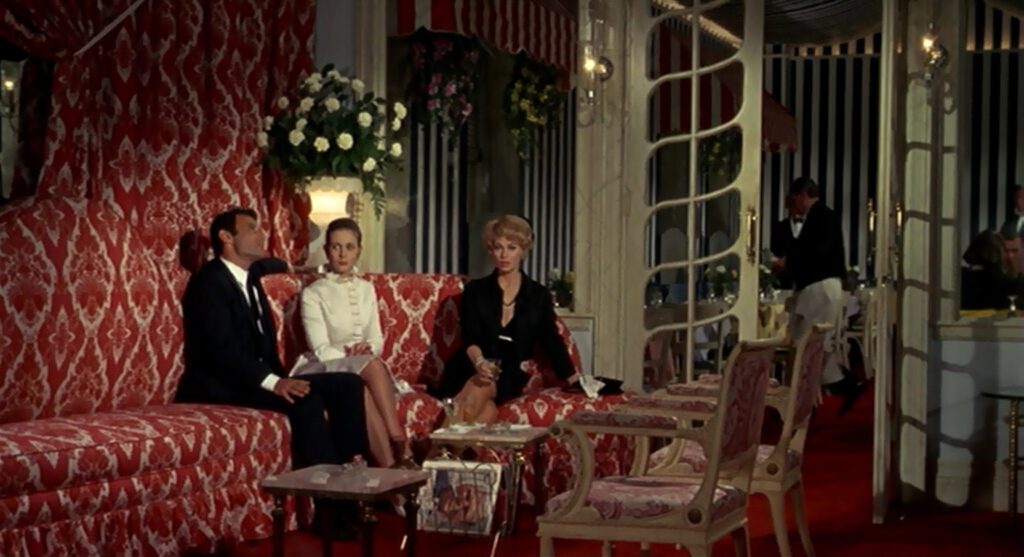
Even the title, Topaz, refers to a gemstone, another kind of ornament – implying that the world of espionage is not like ordinary life. It is an artificial and aestheticized world. Not only is its glamor out of most people’s reach, but there is something deeply false about it, something that does not correspond to reality. Hitchcock spent his career elevating the virtues of ordinariness, from the ordinary American family of Shadow of a Doubt to “Ordinary Smith” in Stage Fright, while saving his wrath, not for the tyrants and masterminds of the world, but rather for ordinary people who, wishing to become special, end up assisting the tyrants. His early espionage films featured ordinary people swept by circumstance into international intrigues, but Topaz is a different story altogether. The movie is about the destructive vanity of espionage.
Only a lazy viewing of Topaz could make a hero of Devereaux. Wherever he goes he leaves in his wake a staggering trail of destruction. Devereaux’s ally Dubois, the florist from Martinique, falls from a window and is lucky to be alive. Luis Uribe is killed, then the entire resistance cell in Cuba is destroyed, including Devereaux’s lover Juanita de Córdoba. The Mendozas are tortured to death and forced to betray their comrades, and the remainder of the cell is arrested, facing probable torture and execution. Henri Jarre is murdered, and a bullet grazes Devereaux’s son-in-law François. In the process the Devereauxs’ marriage is nearly destroyed. The broken china figures were only the first sign of how damaging the business of intrigue and espionage proves to be.
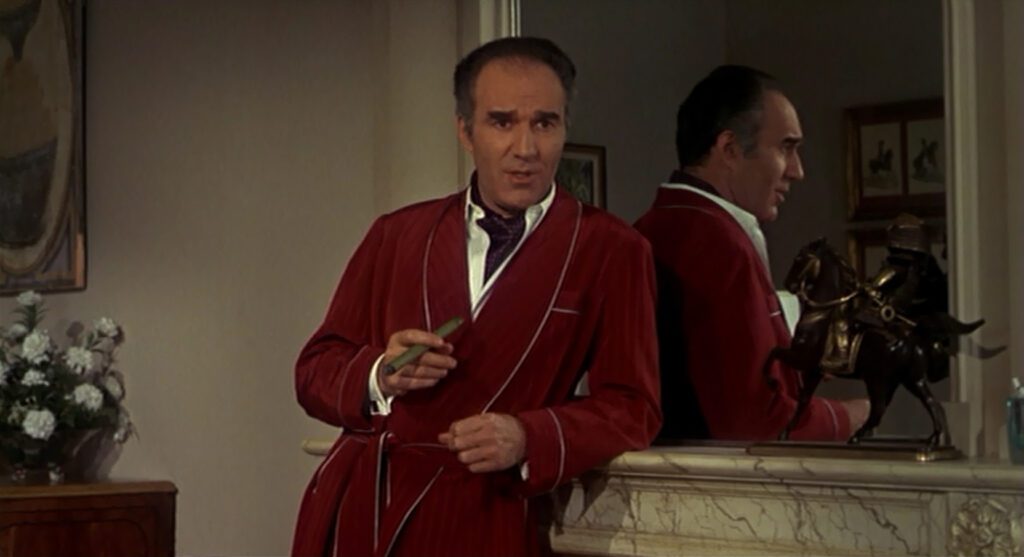
And what, after all, do all these sacrifices accomplish? The Kusenovs defect to the United States where they never prove grateful nor especially helpful. When Devereaux returns from Cuba, Michael Nordstrom thanks him for his intelligence, saying it confirms what they had already learned from U-2 surveillance planes. In other words, all those Cubans’ lives were destroyed, their courage and ingenuity wasted, and some of them put through excruciating pain – simply to confirm what the Americans already knew. Compounding this, Devereaux’s mission added a gratuitous layer of geopolitical risk because he was pressured to report his findings to a leaky French government.
In truth Devereaux is about as un-heroic as he can possibly be short of manifest cowardice. While Dubois risks his life in the Cubans’ hotel in Harlem, Devereaux watches passively from the sidewalk below. While the Mendozas are being tortured, he’s enjoying the luxury of Juanita’s mansion. Moments after Juanita is shot, he is sitting safely on an airplane bound for Mexico. While his son-in-law is interviewing Jarre and getting shot at, he’s resting comfortably at home.
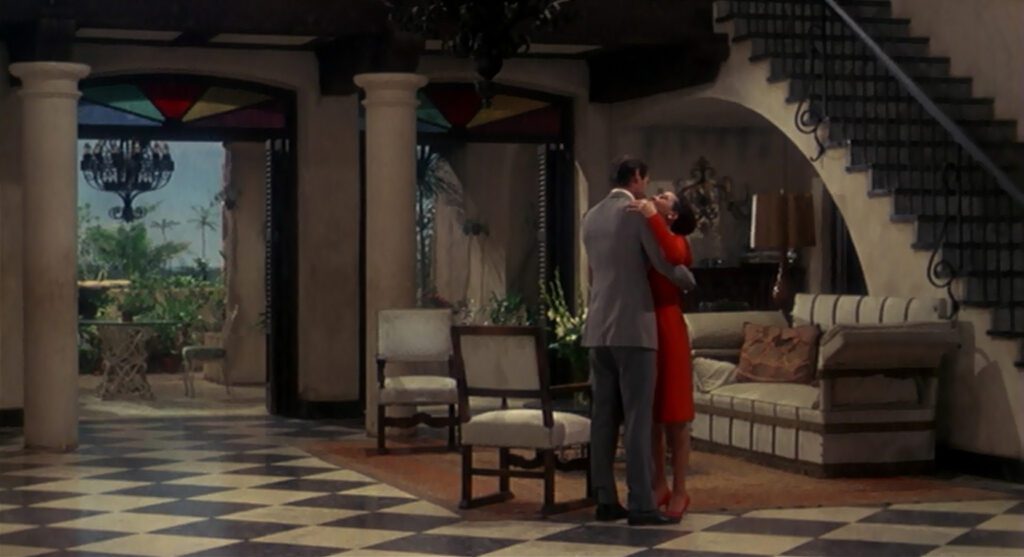
There are two extraordinary and painterly shots in Topaz that contrast bitterly with all the florid and trivial decoration. The first comes as a shock when the Mendozas’ tortured bodies, barely still alive, appear in a pose instantly recognizable from paintings and sculptures of the Pietà – Christ’s corpse in his mother’s arms. The image lays a sudden weight of sadness on the movie; any note of vanity or frivolity would have been inappropriate. Likewise, when Rico Parra shoots Juanita de Córdoba, reminding himself what her fate would be if he allowed her to live any longer, the image matches the gravity of the situation. Shot from overhead, her purple dress spreads out as she sinks to the floor, like a pool of blood draining from her body.
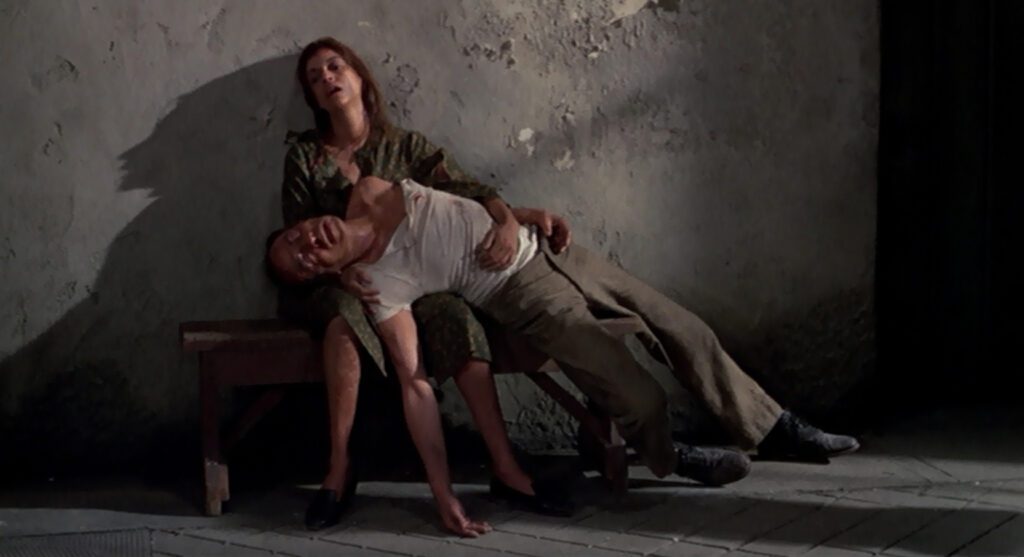
Like several of Hitchcock’s late films, Topaz serves its seriousness unleavened, without the director’s customary perverse humor. The profusion of flowers suggests a funereal tone to match all the tragedy, and in Dubois’ flower shop there are preparations underway for an actual funeral. The movie is bracketed by two tombs: Lenin’s tomb in the opening scene, and the Arc de Triomphe (over the Tomb of the Unknown Soldier) in two of the three endings. Underscoring this solemn tone are a few conspicuous passages of extended silence: in the porcelain factory, in Devereaux’s conversation with Dubois at the florist shop, during Dubois’ entry to the Hotel Theresa and his negotiation with Uribe, and at Juanita’s death.
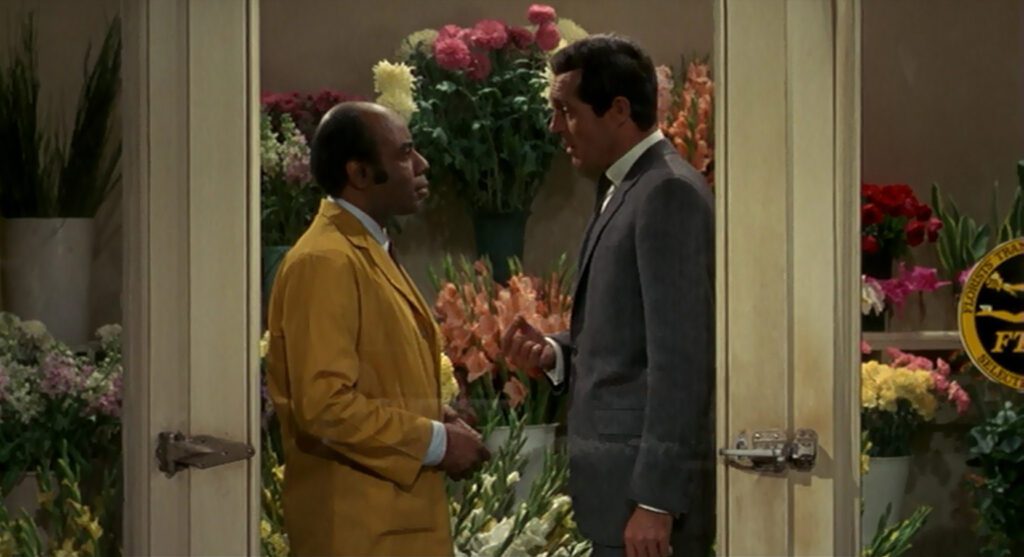
All of these observations should color any reading of Topaz‘s ending, a task complicated by the fact that three different endings were shot and circulated. The original version, shot by associate producer Herbert Coleman when Hitchcock left the set for a family emergency, ends with the sudden and absurd announcement of a duel between Devereaux and Granville, resolved by a Soviet sniper shooting Granville before Devereaux can fire. Hitchcock’s preferred ending, understandably, is the one at Orly Airport where Granville smiles and tips his hat at Devereaux while boarding a flight to Moscow – the traitor’s escape being consistent with the futility of espionage throughout the movie. A third version, shot as a compromise over objections to the villain going unpunished, ends perfunctorily with Granville’s suicide.
The airport and suicide endings, the only ones Hitchcock directed, both conclude with a newspaper tossed on a bench by a Paris boulevard, its headline announcing the end of the Cuban Missile Crisis. The final image in both endings is the Arc de Triomphe at the end of the boulevard. The famous arch is the last in a long series of ornamental decorations, but anyone who has followed the movie’s logic can see a bitter irony in this symbol of triumph. Yes, a nuclear war has been averted, but the events in the movie’s plot played no role in this stroke of good fortune. Any notion of triumph, like the luxury and extra-marital romance enjoyed by these spies, is merely a sign of vanity.
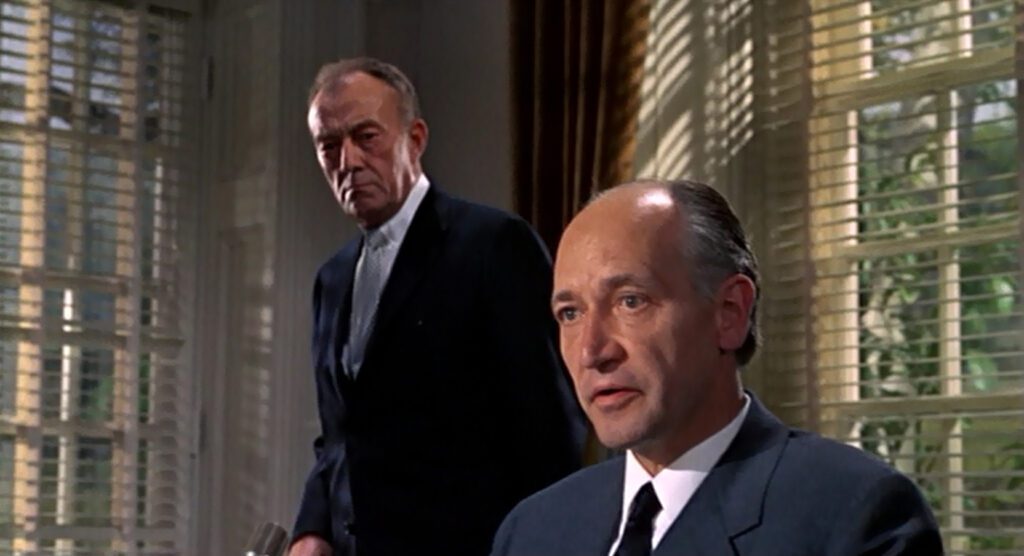
Much like Michael Anderson’s 1966 movie The Quiller Memorandum, Topaz means to counterbalance the glamorous and enticing image of espionage promoted by popular spy films like the James Bond series, showing instead something of the reality behind international intelligence. Coming from Hitchcock, whose career rose on the success of his 1930s spy movies, it is an important acknowledgement that espionage is not fun and games. The ballistic missiles in Moscow and the radioactive material in Cuba reinforce the point. Intelligence work is too important to be entrusted to would-be James Bonds attracted to Hollywood notions of glamor and thrills. The spies in Topaz may look like serious and competent adults, but Hitchcock wants us to look beneath this veneer of professionalism. One of his plainest clues is a detail so incidental that it nearly always escapes notice. The name of Nordstrom’s colleague, McKittrick, comes straight out of Vertigo where it belongs to the hotel where the boyish Scottie’s imagined mother, Madeleine, tricks him to shake him off her trail (“Ma + kid + trick” in Hitchcock’s secret language). Trickery is the substance of espionage, and Topaz wants us to see how the work of spies can become a dangerous form of child’s play.
CONNECTIONS:
Vertigo – The name McKittrick (a hotel in Vertigo, a spy in Topaz)
Fever Mounts in El Pao – Destructiveness of seemingly good intentions
The Quiller Memorandum – Unglamorous truth of espionage